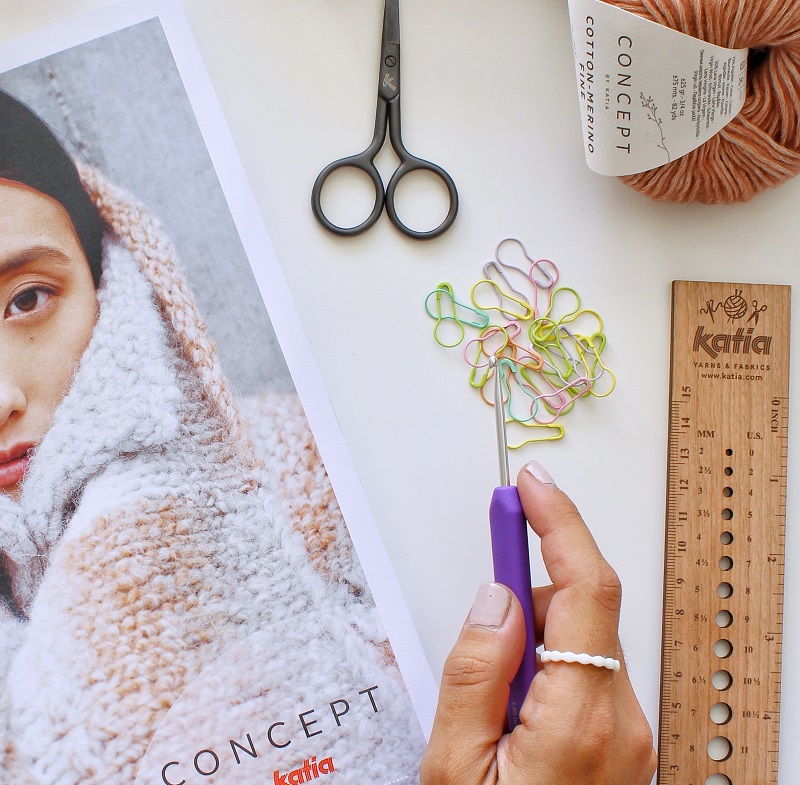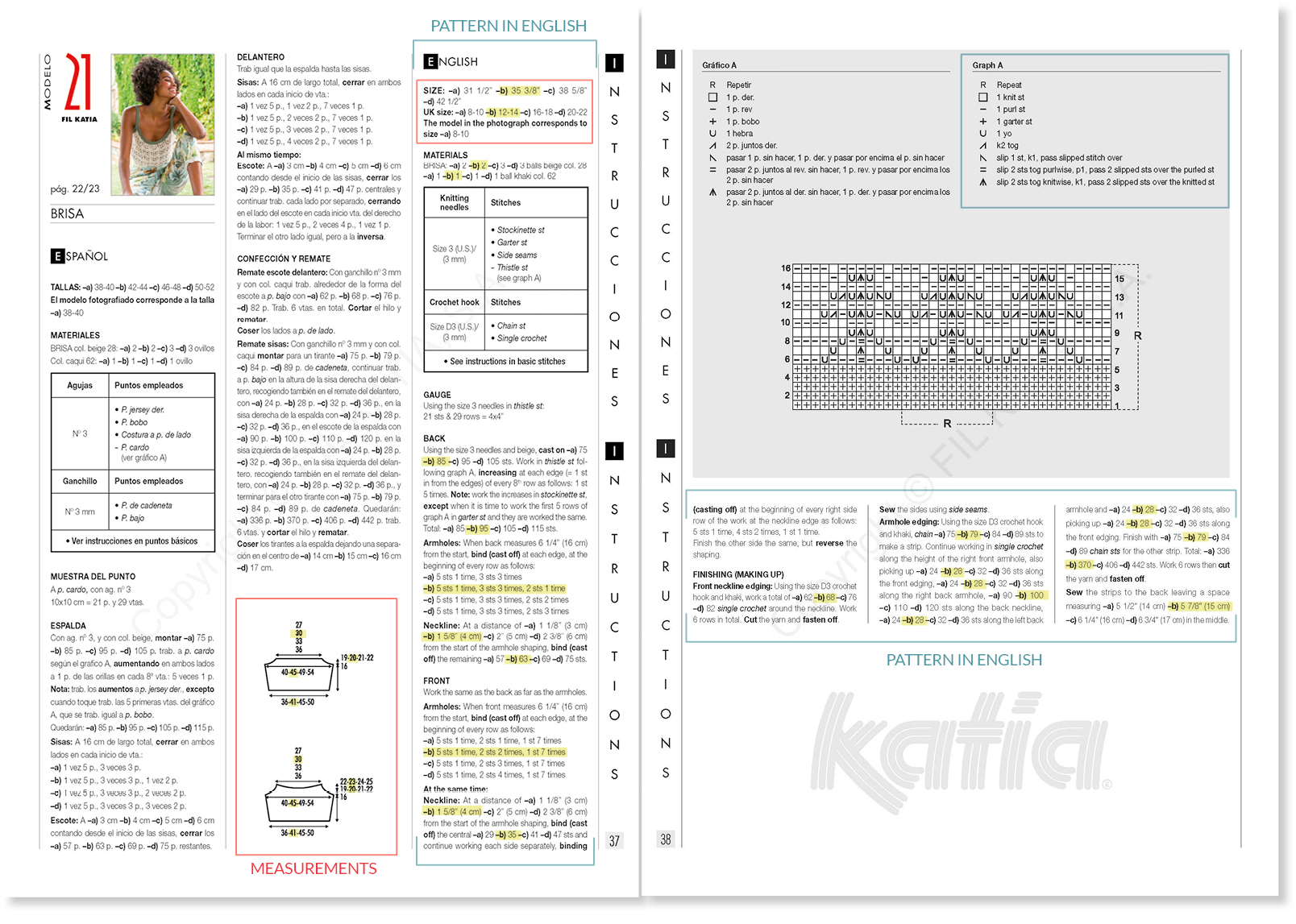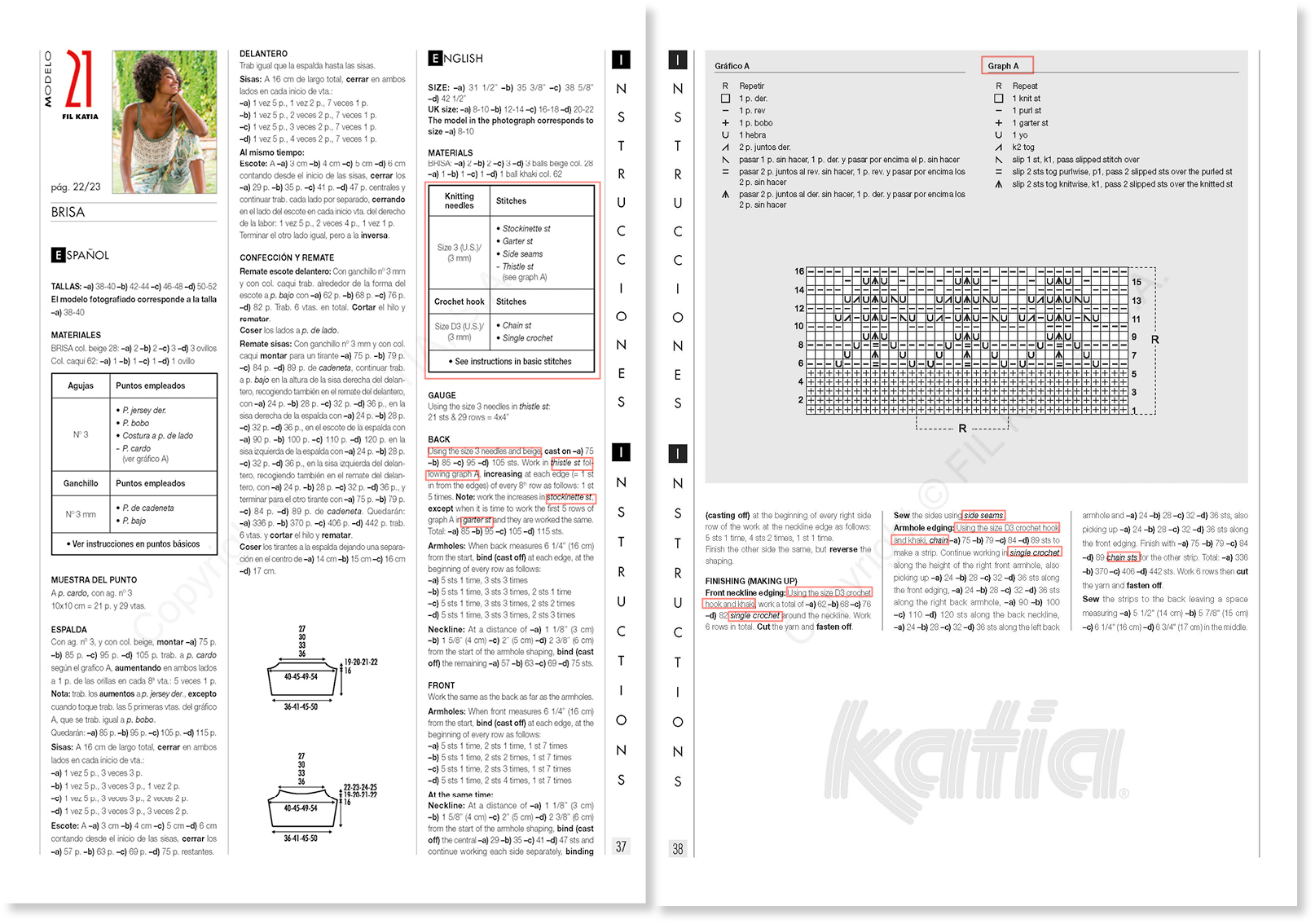This Website uses third-party cookies, which are owned by a person or organization other than KATIA from which KATIA has contracted a service to monitor and improve the services offered on its Website. This third party processes the data gathered by its cookies.
Easy Tips to Read a Katia Knit or Crochet Pattern

Learn, step by step, how to follow our Katia Knit and Crochet patterns
09/01/2022

Whether you crochet or you knit, you may have noticed there are slight differences to how each crocheter/knitter does things. You may hold your hook with a knife hold and the next person uses the pencil hold. Or, you may knit continental style vs English. Whatever your preferences, there are certain standards that will help you when reading a pattern.
Regardless of whether you’re a beginner or you are well on your way to being an expert, we can help you get the most out of our patterns! Below we share 6 tips to help you easily follow our Katia patterns and charts with ease.
6 tips for following Katia patterns
There are many in the Katia community who have been knitting our designs for decades. They know all the ins and outs. But we are also aware that many beginners are knitting Katia patterns for the very first time. For those that would like to learn more, here are 6 tips to follow Katia patterns easily and knit your next project without doubts.
1. Read the pattern through, check the measurements, and mark your size
You fall in love with a project, you pick out your yarn, and you’re ready to go. But, make sure you do the following things first . . . .
-
Read the pattern through carefully. All of our patterns are available online in pairs of two languages: Spanish–English, French-Dutch and German-Italian.
-
Check the measurements to find your correct size and the number of balls required for your size (see boxes in red). Note: Measurements are always indicated in centimeters.
-
Underline or mark the instructions that are specific for your size (see example for size b) 42-44). Note: If there is only one number given, it applies to all the sizes.
This simple preparation helps you follow the pattern more easily, as well as alleviate doubt and confusion during the project.

2. When and How to Knit/Crochet the Stitches
In each of our patterns you will find a table that indicates the size of the needles and/or crochet hooks, along with the stitches that are used. The pattern will tell you which number of hook or needles is needed, which yarn color and which specific stitch.

Guide to Basic Stitches
If you need help with basic knit stitches, please see our Instructions in Basic Knitting ebook. It includes abbreviations used in patterns, a table of equivalences for our yarns, useful tips, and how to follow a crochet chart. Download yours and today!
Videos of basic stitches and other techniques
If you’re a visual learner, or you’d like to see how to knit basic stitches and techniques, you can take a look at our YouTube channel. Here we share videos like knitting with standard needles, circular needles, as well as crochet stitches.
Graphs with symbols and a legend
If you come across stitches you’re unfamiliar with, and there’s no video or stitch guide, don’t worry! These stitches are explained row by row – following the table of stitches used – or with graphics that contain symbols and a legend. Which brings us to the third of the 6 tips for following Katia magazine patterns…
3. How to Read a Graph Correctly
Have you ever heard the saying . . . One step at a time. Well, with knitting and crochet patterns it’s exactly the same thing. One stitch at a time. One square at a time. If you want to know how to read this grid full of symbols, here are some tips to correctly interpret a graph:
-
Each square on a graph corresponds to a stitch explained in the symbol legend.
-
Stitches are worked horizontal and rows are indicated in the vertical
-
Odd rows are read from right to left (1, 3, 5 …), while even rounds (2, 4, 6 …) are read from left to right. Odd number rows are located on the right and even numbered rows are on the left of the graph. This way you can easily see each row.
-
What about that R? The R means you should repeat everything that is included between dashed lines. In our example, we repeat the 10 stitches indicated horizontally and the 16 rows of the graph.
-
Be sure to work the stitches that are before and after the repeat indicated by R.

Graphics with letters
The above chart is the same for all sizes, but you may also find separate charts for each size, depending on the pattern. In this case, uppercase letters are used (e.g. A, B, C, D, E) to indicate the stitches of the graph that need to be knitted according to each size. Note: The uppercase letters (A, B, C, D, etc.) do not correspond to sizes with small letters (a, b, c, d, etc.). Sometimes, however, it could occur that the knit size b) is indicated between B and B in the graph. Always follow what is indicated in the written pattern to know from which letter to which letter of the graph you need to knit for each size.
Here is an example with different instructions depending on the size. The box in red (between letter D and D) is what we have to follow if we want to knit size b).

4. Stitch tension & gauge
The tension of the yarn and the movement of the needles may change from one person to another. To avoid frustration, we recommend you first make a little square, sometimes referred to as a gauge swatch. Invest some time and yarn and knit a sample with the same needle and stitch number indicated in the GAUGE section of a pattern. Then count how many stitches and rows equal 10 x 10 cm. If you get less stitches and rows than indicated in the pattern, you can make another sample with smaller needles. On the other hand, if you end up with more stitches and rows than indicated, you can try to make a sample with bigger needles. Stick with the needle size that is closest to the 10×10 gauge indicated in the pattern!
How to count rows and stitches in a 10×10 square
Check out the next video!
Recommendation: To knit your sample, add 4 or 6 extra stitches to the number of stitches indicated in the 10×10 of the pattern. Also, knit a few more rows than indicated, so you will have enough margin to count full stitches.
5. What does it mean…
We will walk you through some common terms and written explanations that you will see in a pattern. We are going to solve some of the most frequent questions.
-
… increasing at each edge (=1 st in from the edges) of every 8th row as follows: 1 st 5 times
This means you knit 1 stitch (= edge stitch), make 1 increase in the next stitch and continue knitting as indicated in the pattern until you reach the last 2 stitches of the row. Here you increase again and end with 1 stitch in the last stitch (= edge stitch). You now have increased on both sides 1 stitch from the edge.
You continue knitting without increasing 7 more rows. On the 8th round you increase again on both sides, repeating what was explained above. Keep increasing on both sides 1 stitch from the edge every 8 rows.
You repeat this (increase 2 stitches on every 8th round, after the first edge stitch and before the last edge stitch of the round for a total of 5 times. This means you increase a total of 10 stitches (2 increases x 5 times), after knitting 40 rows (every 8 rows x 5 times).
In this video we show you how to increase stitches on both sides, at the beginning and end of the row, on the right side of the piece:
What does edge stitch mean?
The first and last stitch of each row are called the edge stitches. As simple as that!
Is that the same as the selvage stitch? No, that is something different… If you want to know more about the basic stitches, you can download our stitch guide here.
-
… bind (cast off) at each edge, at the beginning of every row as follows: -c) 5 sts 1 time, 3 sts 3 times, 2 sts 2 times.
You are going to cast off on both sides at each beginning of a row, that is, you must cast off at the beginning of the row on one side (= the good side of the piece) and at the beginning of the row on the other side (= the wrong side of the piece). You cast off 5 stitches at the beginning of the next 2 rows, in other words, you cast off 5 stitches on both sides 1 time (= 10 stitches total).
Then, you cast off 3 stitches at the beginning of the row (= knit side of the piece) and another 3 stitches at the beginning of the next row (= purl side of the piece). This must be repeated a total of 3 times. Remember that we bind off on both sides (= start of row knit side + start of row purl side) 3 times (= 6 rows ), 3 stitches each time (= 18 stitches total).
Finally, you cast off 2 stitches at the beginning of each of the next 2 rows (= knit side + purl side). You have to do this 2 times total (= 4 rows / 8 stitches).
In total, you knit 12 rows and cast off a total of 36 stitches (= 18 stitches on each side).
How to cast off stitches with two needles?
In this video we show you how to make a simple cast off with 2 needles:
6. Visit the Model Clarification section on our website
We will end the sixth tip with a final saying: Making mistakes is human. And behind Katia there are quite a few humans! When we make a mistake, we add a correction in our Magazine Corrections section of the Katia Academy. Before you start knitting a pattern, we recommend checking out the magazine model updates. If you find any clarification of your model, download the PDF to make your pattern information complete. If you come across a mistake or something that does not add up in our patterns, please notify us through this contact form. Our Magazine Team reviews each query as soon as possible so you can continue with your project happily.
<insert image>
Hopefully, these 6 tips will help you to follow Katia patterns more easily. If you have any other tricks or questions about how to read a pattern, please leave a comment below. Thanks for reading to the end!
Still looking for the perfect pattern? Check out our seasonal patterns


Validate your login
Sign In
Create New Account